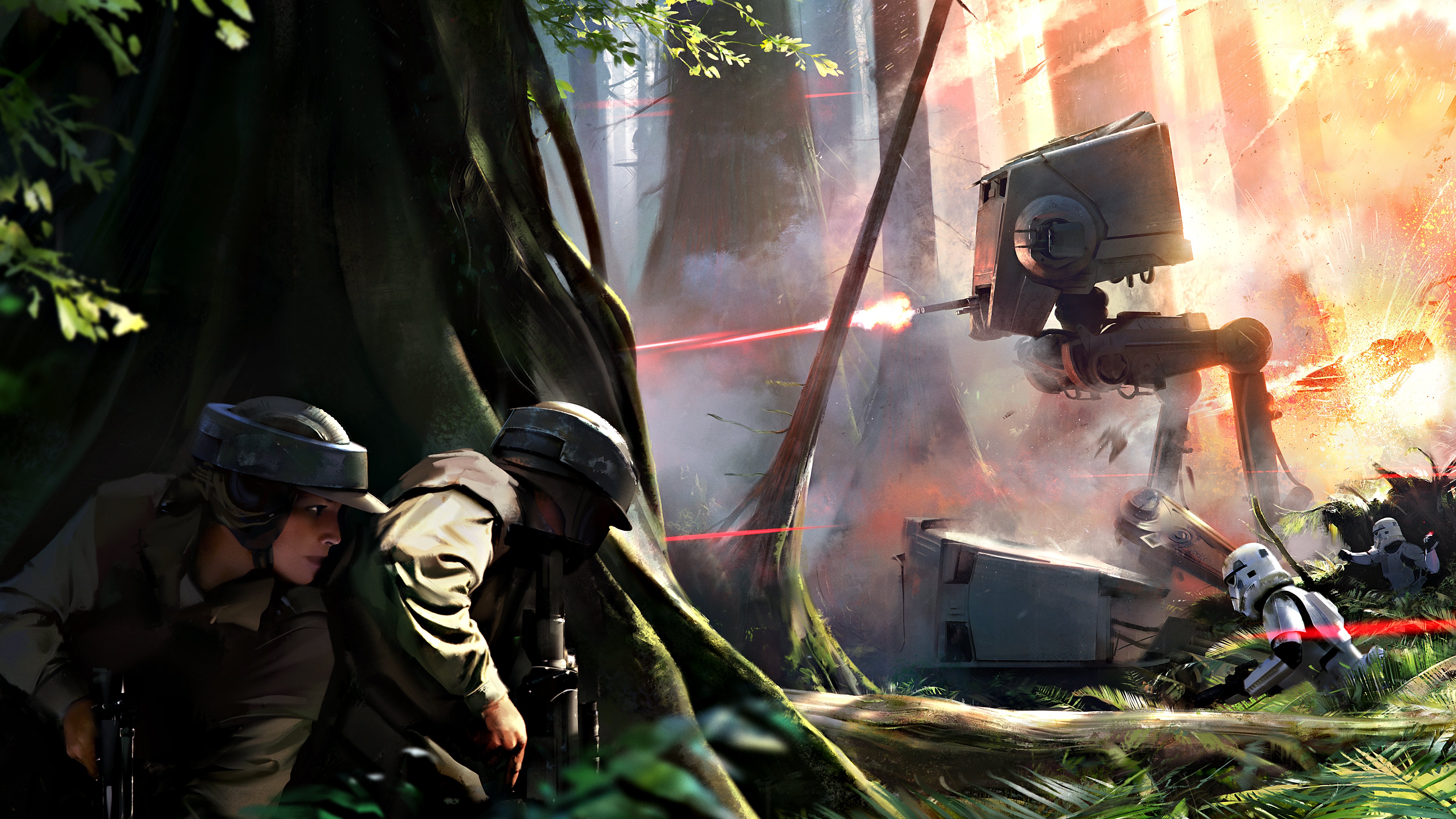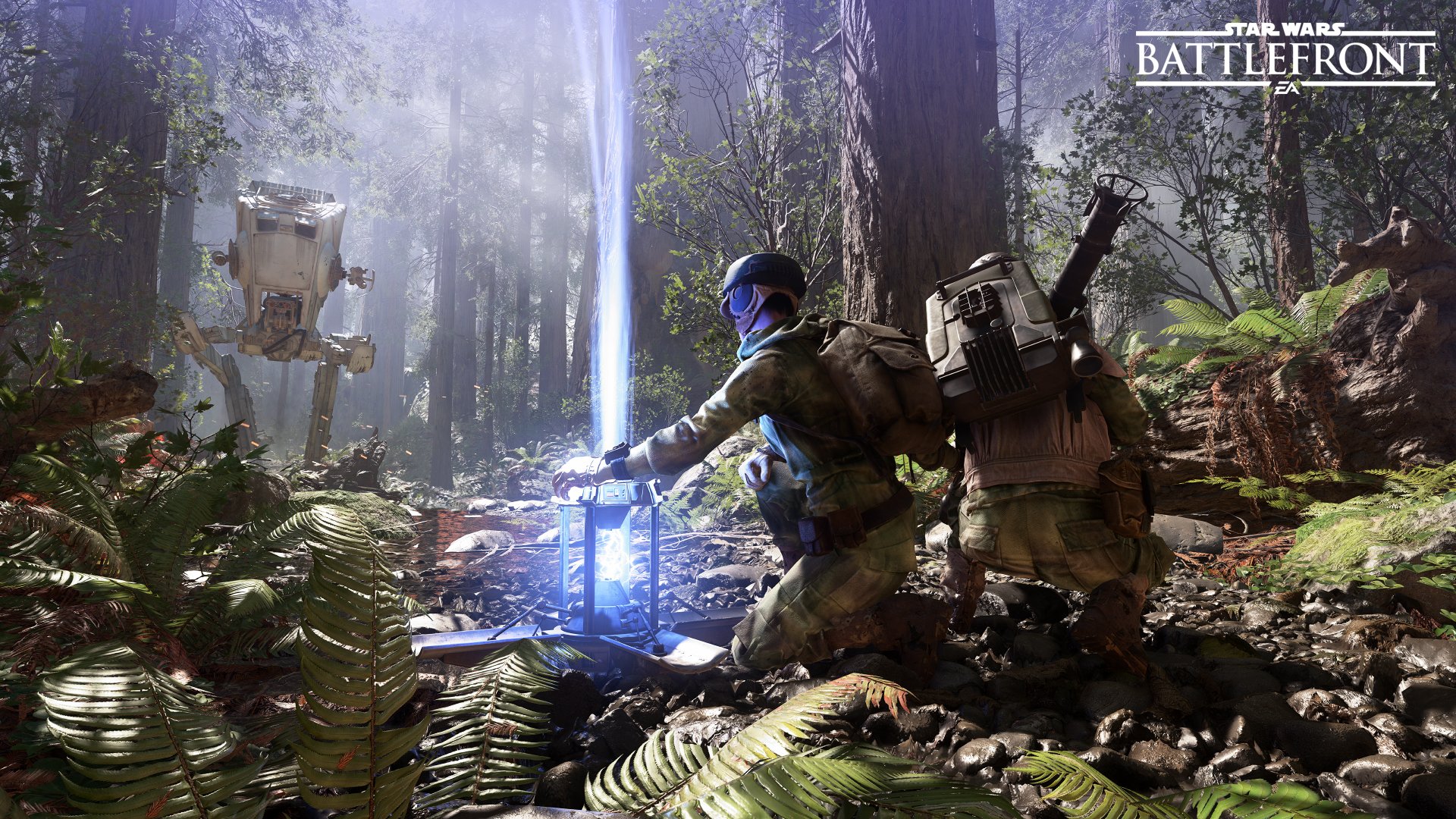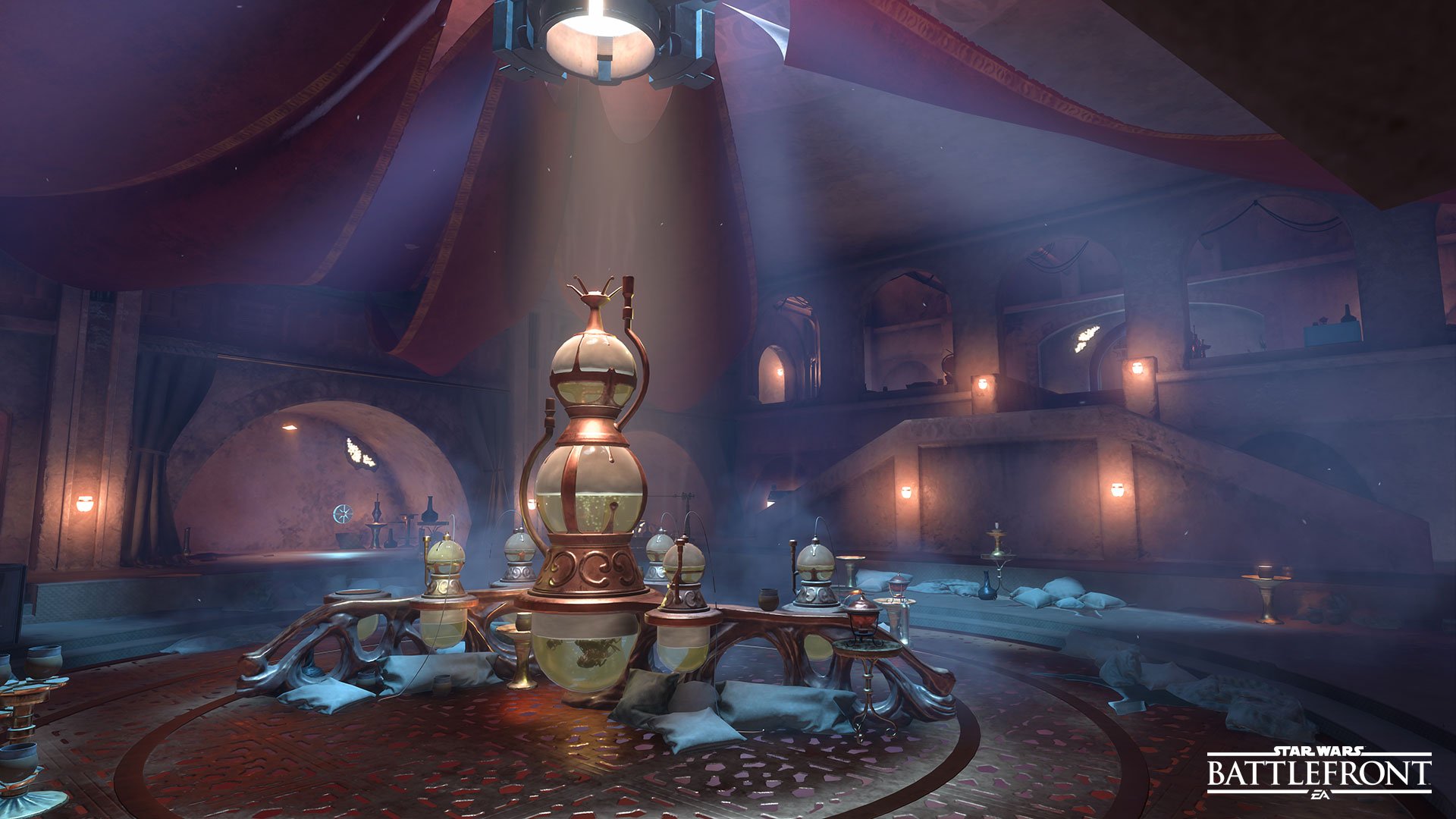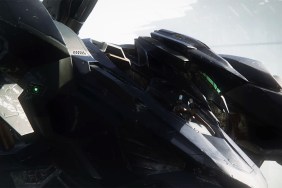Like a J.J. Abrams movie, a lot of flash but little substance… which may be enough.
With Star Wars: Battlefront on the way, but with no one on the servers to play it, EA held a review event at their Redwood City offices last week. Rather, they held the event in the basketball gymnasium in EA’s fitness center, converted to reflect the kind of posh hotels gaming events are often held at, with everything draped in shiny reflective cloth and the game logo projected on the walls. The whole thing felt a Senior Prom for Star Wars nerds.
Battlefront is a bit like a high school dance, a huge number of awkward nobodies all striving their best to achieve, dancing away in vain while the popular kids (your Lukes, Darths, Han Solo, and The Fett) rule with a meteoric rise and sudden and—and often explosive—downfall. You can also play as Princess Leia or Emperor Palpatine, but these are the kinds of kids who were popular, but no one really ever understood why, since nobody seemed to like them much. After that, this analogy falls flat because, well, it’s Star Wars, and the enthusiasm for that completely takes over. (Or doesn’t, depending on your level of fandom for the series.)
Battlefront took a bit of a critical drubbing when they released their open beta earlier this year from players who were expecting…something else from DICE. Some I’ve spoken to have gone so far as to cancel their pre-orders for the title based on their beta experience. This may have led EA to the decision to handle their review event in a manner that led to Polygon choosing not to attend the event which ironically feels like a mitigating strategy for a lack of confidence in the product. All this amounts to a kind of P.R./games journalism politicking that may annoy some readers, but I think it’s worth mentioning because reviews aren’t formed in a vacuum, no matter how hard we try to remain focused exclusively on the games themselves.
To assuage some fears, Star Wars: Battlefront is a deeper game than the beta implied and also a much more balanced one. During the beta, certain game-changing features, like the more comprehensive tutorial missions that allowed players to get a handle on vehicles and heroes, weren’t available. Actually knowing how the T-47 Snow Speeder’s tow-cable mini-game works, for instance, almost completely balances the Walker Assault game mode that seemed to heavily favor the Imperials in the beta. Even with better player training and a large variety of gameplay, Battlefront is still—sometimes to its benefit and sometimes to its detriment—a heavily curated experience, with game modes that keep the areas of play tight even on the larger maps.
What Battlefront does better than any game I’ve played on current-gen consoles is reproduce the feel or experience of a filmic environment. While this varies to a certain degree, depending on the area (after all, a snow planet like Hoth is only so interesting), places like the Forest Moon of Endor and the volcanic planet Sullust have a kind of beautiful naturalism that at the clean 60fps framerate (that didn’t seem to dip) feels like stepping through a window into other worlds, and the 900p resolution didn't bother me considering the fluidity of the experience. This is enhanced greatly when jetting around on a speeder bike between trees or hunting down droids that say “donk!” behind volcanic crags.
Though you may miss some of this in the smaller multiplayer modes and missions, since the action tends to be fast. The game is designed for play in the mission content first, to train the player in how to play the game in terms of enemy hit points, strength, targeting weaknesses, etc. The missions are broken into tutorials (basic character, vehicle, and hero instruction), versus modes (both standard and hero modes), and a survival wave-based mode that pits one-to-two players against 15 waves of increasingly difficult AI Imperial attackers. These modes don’t apply experience points towards the multiplayer character levels, but do provide credits that can be used for weapon and ability unlocks in multiplayer.
Weapons and ability “star” cards are much more varied and versatile than in the beta, though weapons still field what feels like a shallow pool with only eleven guns and most blasters feel like mid-range rifles, with one sniper rifle (the excellent T-21B targeting rifle, unlockable at level 21) and one shotgun (the CA-87 shock blaster, level 8). Buying the Deluxe Edition (or a more exclusive edition) of the game gives you immediate access to Han Solo’s DL-44 overpowered hand-canon and anti-vehicle ion weapon Star Cards (which do have a slight pay-to-win/pay-to-advance feel to them).
Star Cards are much, much more varied than in the beta (which offered only a few select choices) with thirteen secondary weapons tied to a brief cooldown period. There are also energy options that include alt modes of fire, a personal shield, and targeting pulse that require energy to use that can be found on the battlefield. Finally, there are five "trait" class cards that begin unlocking at level fifteen that grant bonuses and augment player abilities. This allows players to build custom “hands” with two ability cards (like thermal detonators and single-shot sniper rifles), one energy card, and one trait card. While this allows for a much greater variation in terms of play, it still feels somewhat shallow at launch and hopefully will be expanded as the game continues to be supported.
Also unlockable are cosmetic options for both rebel and imperial versions of your player character and emotes. My favorite emote is one where the PC does a little mock-lightsaber fight, making vrrm-noises while he or she pretends to lock blades with another duelist. Doing this as a stormtrooper after taking down an opponent is particularly funny-looking.
The game is built on its multiplayer modes and designed for players to start with the smaller 6-12 person maps for Droid Run and Drop Zone, which involve securing specific map objectives like droids or escape pods filled with materials. Cargo is the game’s capture-the-flag mode where teams compete to capture five cargo modules at enemy bases. Blast is a medium-sized game that serves as Battlefront’s team deathmatch mode. There’s a dogfight mode, Fighter Squadron, where the player enters a swarm of aerial combat with the Millenium Falcon and Slave 1 taking on hero roles.
There are two hero modes: Hero Hunt, where 5-7 grunts take on a single hero or villain, with the person who made the killing blow assuming command of the hero in the next round; and Heroes vs. Villains, where Luke, Han, and Leia face off against Vader, Boba Fett, and Emperor Palpatine. When you die in this mode as a hero, you respawn as a Rebel or Imperial footsoldier to aide the heroes.
The real focus of the game, though, are its two giant modes, Walker Assault and Supremacy, which includes foot soldiers, heroes, and vehicles. Players of the beta will be familiar with the Hoth level of Walker Assault, but play strategy varies heavily depending on which planet it takes place on. In the mode, the Imperial walkers move along a fixed path, and rebels and imperials vie for control of uplink stations to call in rebel bombers that can make the walkers vulnerable to physical attacks and being tripped using airspeeder tow-cables. This mode is the most different on the Forest Moon of Endor, where the dense forest trees mean taking on only one walker (instead of the usual two) but without the benefit of air speeders.
The final mode, and my favorite, is Supremacy, in which you fight to take capture points in a specific order, but the enemy faction is fighting to advance along the same path. This means having to balance between advancing to the next point and defending your most recent conquest from being taken by the enemy. Having the advancement linked to a linear progression means that combat is intensified on that frontline, with an intense no-man’s land often emerging between capture points. If you lose a point, you have to fall back to try to regain it, while enemies may be spawning in greater numbers around you.
All of this makes for compelling, intense gameplay where whatever your style, there’s a sense of accomplishment to help push forward the larger combat goals. If you pick up a hero token, your expanded abilities as iconic characters (much easier to play after player training) allow you to clear a path to these objectives for your team, or engage in death duels with the other team’s heroes or villains to distract them from other players. Vehicles also play specific roles in providing heavy ground or air support. However, most of the time you’ll be infantry dashing headfirst or using your jump-jet pack to fly headfirst into those large segmented battle areas.
One of the biggest problems I have with Star Wars: Battlefront is how tightly packaged everything is. The larger modes like Supremacy and Walker Assault have the area of combat tightly gated, so that spawn points are tied to capture or timed objectives, rather than the areas of faction control. This means you always spawn just behind the area of combat. One way to break the game is to run as far around the active battlefield as possible to the next objective area, jump into an anti-vehicle turret and just wait for the objective area to move to you, then pick off all the enemies spawning in the area.
This is compounded in a mode like Supremacy in that there doesn’t seem to be any reason for taking specific capture points. There’s no tactical advantage, for instance, in taking the point beneath a jawa sandcrawler, opposite the high ridges that provide excellent elevation and cover. While the mode is fun, after a while it starts to feel—without a mode that simply has an open map—like DICE has no confidence in the players to move the frontline of the battle organically, to natural tactical objectives or goals. While I suppose one could argue that this mirrors the experience of real boots-on-the-ground soldiers who are often frustrated by command decisions that make no sense from the thick of the fight, it makes the game feel like it’s doing a certain amount of handholding and watering down of the experience.
Battlefront is at its best when the fighting is so thick and intense that you just don’t notice this, combined with the awe of the Star Wars nostalgic glee it can sometimes engender. In one Hoth Walker Assault game, I whooped in glee as a small rebel squad I had been fighting with finally took out the chicken-walker AT-ST that had been picking us off, only to have an X-Wing fighter engaged in a strafing run suddenly explode directly above us followed by the sound of a TIE Interceptor screaming past, while in the middle distance Luke Skywalker performed an impossible jump from one ridge to another, with the John Williams score blaring in the background. Moments like that, are what Battlefront lives for, banking on the nostalgia of players who can now live out the fantasies they played with action figures in their childhoods.
Whether or not Star Wars: Battlefront is worth your dollar may depend on three things: how much you love Star Wars, how much you wanted this to be Battlefield with lasers instead of its own game, and how much you are willing to gamble on EA and DICE supporting it with enough additional DLC content to keep it continuously interesting moving forward. As an audio-visual spectacle it screams Star Wars, but it feels thin presently. Hopefully, with the Battle of Jakku content coming just a few weeks after launch, we’ll see what that support will look like in the near future. Right now, it’s bigger than life, feels good while you're enjoying it, but is somewhat disappointingly hollow.
Review based on PS4 version during a review event setup by the publisher. Also available on Xbox One and PC.
-
Fun larger maps
-
...that feel strangely constrictive
-
Great original trilogy atmosphere
-
No story
-
Well balanced gameplay
-
Options feel slightly shallow
-
One of the best looking games on current-gen consoles
-
Lower resolution
star-wars-battlefront-2014
-
star-wars-battlefront-2014 #1

-
star-wars-battlefront-2014 #2

-
star-wars-battlefront-2014 #3

-
star-wars-battlefront-2014 #4

-
star-wars-battlefront-2014 #5

-
star-wars-battlefront-2014 #6

-
star-wars-battlefront-2014 #7

-
star-wars-battlefront-2014 #8

-
star-wars-battlefront-2014 #9

-
star-wars-battlefront-2014 #10

-
star-wars-battlefront-2014 #11

-
star-wars-battlefront-2014 #12

-
star-wars-battlefront-2014 #13

-
star-wars-battlefront-2014 #14

-
star-wars-battlefront-2014 #15

-
star-wars-battlefront-2014 #16

-
star-wars-battlefront-2014 #17

-
star-wars-battlefront-2014 #18

-
star-wars-battlefront-2014 #19

-
star-wars-battlefront-2014 #20

-
star-wars-battlefront-2014 #21

-
star-wars-battlefront-2014 #22

-
star-wars-battlefront-2014 #23












